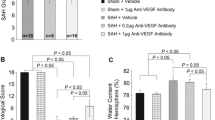Summary.
Vascular endothelial growth factor (VEGF) is a major mediator in angiogenesis and vascular permeability. In central nervous system (CNS) it plays a pivotal role as: 1. inductor of endothelial cell proliferation, migration and inhibition of apoptosis, and 2. mediator of vascular permeability and subsequently of brain edema. This ubiquitous epiphenomenon is a major complication in several CNS pathologies, including head trauma and stroke.
After brain injury the expression of VEGF is increased contributing to disruption of the blood brain barrier (BBB). VEGF increase the permeability of BBB via the synthesis/release of nitric oxide and subsequent activation of soluble guanylate cyclase. The immunohistochemistry shows an increase of stained astrocytes and endothelial cells around cortical micronecrosis. VEGF immunopositivity distribution shows some correspondence with the blood brain barrier breakdown following a cortical micronecrosis.
Similar content being viewed by others
Author information
Authors and Affiliations
Additional information
Received July 3, 2001 Accepted August 6, 2001 Published online September 10, 2002
Rights and permissions
About this article
Cite this article
Lafuente, J., Bulnes, S., Mitre, B. et al. Role of VEGF in an experimental model of cortical micronecrosis. Amino Acids 23, 241–245 (2002). https://doi.org/10.1007/s00726-001-0135-1
Issue Date:
DOI: https://doi.org/10.1007/s00726-001-0135-1




